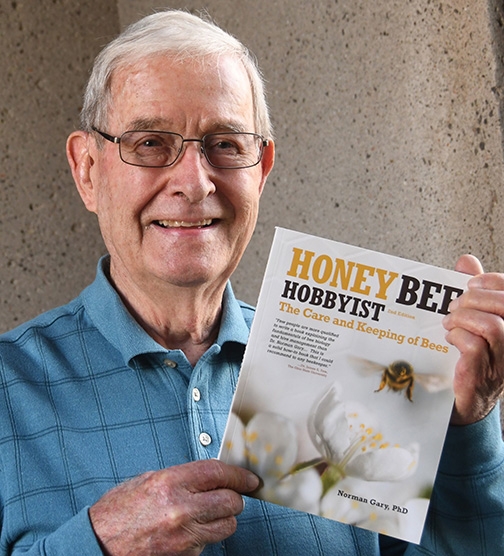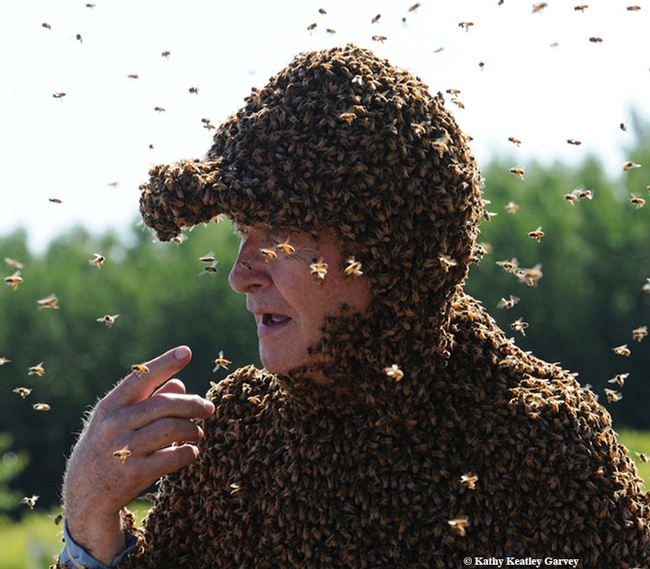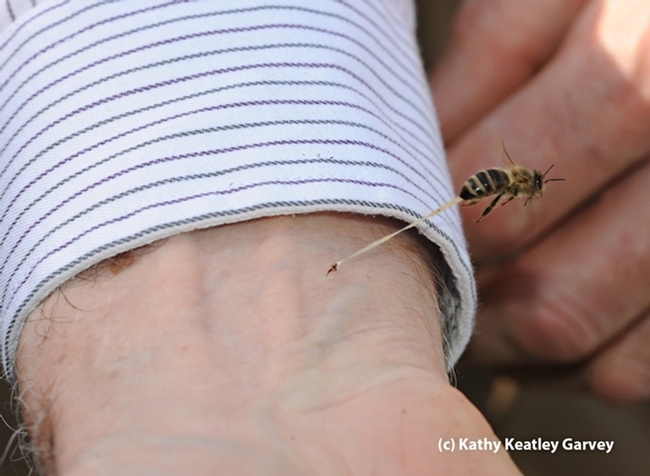
When folks hear about the 70-year beekeeping/bee wrangling career of 85-year-old apiculturist Norman Gary, emeritus professor of entomology at the University of Davis, they ask:
"How many times have you been stung?"
Let's see, can you guess?
Gary, internationally known as "The Bee Man," began keeping bees at age 15 in Florida. His career includes hobby beekeeper, commercial beekeeper, deputy apiary inspector in New York, honey bee research scientist, entomology professor, author, bee wrangler and Guinness World record holder.
He once trained bees to fly into his mouth to collect food from a small sponge saturated with artificial nectar. His holds the Guinness World record (109 bees inside his closed mouth for 10 seconds) for the stunt. He's also the person behind the "bee suit" record in the Guinness World Records; Gary clustered more than 87 pounds of bees on a friend.
So, how many times has he been stung?
"I didn't keep records, of course," the Sacramento-area resident understandably points out. "Many thousands for sure! I was probably stung over a thousand times during one summer as an apiary inspector in New York state. We didn't wear gloves."
"People don't understand that a sting is not very significant if you remove the stinger within several seconds before much venom is injected," he says. "So we worked fast and took chances that resulted in more stings but we didn't mind that much because we developed a strong tolerance, without significant reactions, and removed the stings instantly."
"During my long career, I manipulated much greater numbers of colonies more frequently than most bee researchers because my research was field-oriented. So several hundred stings per year for 70 years is a lot of stings. My guess is that the total number of stings would be around 20,000. Unfortunately the sting number estimates were greatly exaggerated during some of my TV shows. But that is show biz!"
Gary, author of the newly published Honey Bee Hobbyist: The Care and Keeping of Bees, second edition, writes in his book that "most people have an exaggerated sense of dread concerning bee stings due to a wealth of misleading negative information in the media."
Bees are defensive, not aggressive, he says. "Defensive behavior happens only when you are very close to the hive. Bees foraging on flowers or collecting water certainly have the ability to sting, yet they behave as if hey are totally defensiveless. They will fly away in response to the slightest disturbance. Remember, a bee that has stung dies within a few seconds and the colony benefits only if this sacrifice is made in defense of the colony."
Gary, who holds a doctorate in entomology from Cornell University, joined the UC Davis entomology faculty in 1962, retiring in 1994 after a 32-year academic career. He has authored more than 100 publications, including scientific papers, book chapters and popular articles in beekeeping trade journals. During his professional bee wrangling career spanning four decades, “The Bee Man” served as a consultant and bee stunt coordinator for 17 movies, 70 TV shows and six TV commercials. Among his credits: the movie, “Fried Green Tomatoes” and TV appearances with Johnny Carson and Jay Leno.
In his book, Gary covers activities inside and outside the hive, reproduction, management of colonies, honey and other products, urban beekeeping, beekeeper education (he mentions the UC Davis-based California Master Beekeeper Program), and entertaining with bees, among other topics.
That's in addition to colony defense and sting prevention. "The Bee Man" zeroes in on stinging behavior, getting stung, minimizing the effects of stings, reactions to stings, and why bees sting.
Why do they sting? "Defensive behavior is necessary for their survival, to protect the colony and the stored honey and pollen."
Attached Images:

"Bee Man" Norm Gary clustered with bees during a bee wrangling stunt. (Photo by Kathy Keatley Garvey)

Close-up of a bee sting. This photo was taken when a guard bee was defending her colony. Note the stinger embedded in the arm and the stretched abdominal tissue as the bee pulls away. (Photo by Kathy Keatley Garvey)